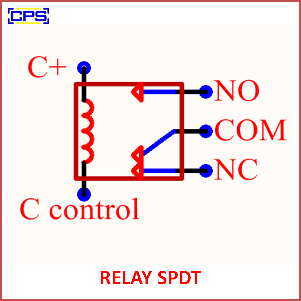A Relay SPDT (Single Pole Double Throw) is an electromechanical or solid-state switch that controls a circuit using an electrical signal. It consists of a single input (pole) and two output paths (throws), allowing it to toggle between two circuits. An SPDT relay can switch one input connection between two outputs.

Key Features of an SPDT Relay
- Single Pole, Double Throw:
- Pole: The movable contact that connects to either of the two output terminals.
- Throws: Two fixed terminals (Normally Open and Normally Closed).
- Control Mechanism:
- Operated by an electromagnetic coil (in electromechanical relays) or a control signal (in solid-state relays).
- Configuration:
- One terminal is Normally Closed (NC), meaning it is connected to the input when the relay is inactive.
- The other terminal is Normally Open (NO), meaning it is connected to the input when the relay is activated.
Working Principle:
- When no power is applied to the relay coil:
- The input (pole) is connected to the NC terminal.
- When power is applied to the relay coil:
- The magnetic field pulls the pole to connect it to the NO terminal.
Applications of SPDT Relays:
- Control Systems:
- Used in automation to switch between two different states or signals.
- Changeover Circuits:
- Selects between two power sources or signal paths.
- Signal Routing:
- Used in communication systems to route signals to different circuits.
- Switching Loads:
- Controls devices like motors, lights, or alarms based on input signals.
Advantages:
- Can control multiple circuits with a single input.
- Provides electrical isolation between control and output circuits.
- Versatile and widely used in automation.
Disadvantages:
- Electromechanical relays are slower compared to solid-state switches.
- Mechanical wear can occur over time in electromechanical relays.
- Solid-state relays may be more expensive for high-power applications.
